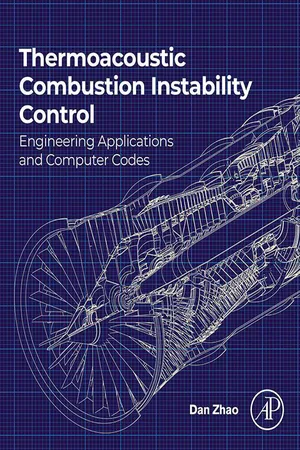
Thermoacoustic Combustion Instability Control
Engineering Applications and Computer Codes
- 1,144 pages
- English
- ePUB (mobile friendly)
- Only available on web
About This Book
Thermoacoustic Combustion Instability Control: Engineering Applications and Computer Codes provides a unique opportunity for researchers, students and engineers to access recent developments from technical, theoretical and engineering perspectives. The book is a compendium of the most recent advances in theoretical and computational modeling and the thermoacoustic instability phenomena associated with multi-dimensional computing methods and recent developments in signal-processing techniques. These include, but are not restricted to a real-time observer, proper orthogonal decomposition (POD), dynamic mode decomposition, Galerkin expansion, empirical mode decomposition, the Lattice Boltzmann method, and associated numerical and analytical approaches.
The fundamental physics of thermoacoustic instability occurs in both macro- and micro-scale combustors. Practical methods for alleviating common problems are presented in the book with an analytical approach to arm readers with the tools they need to apply in their own industrial or research setting. Readers will benefit from practicing the worked examples and the training provided on computer coding for combustion technology to achieve useful results and simulations that advance their knowledge and research.
- Focuses on applications of theoretical and numerical modes with computer codes relevant to combustion technology
- Includes the most recent modeling and analytical developments motivated by empirical experimental observations in a highly visual way
- Provides self-contained chapters that include a comprehensive, introductory section that ensures any readers new to this topic are equipped with required technical terms
Frequently asked questions
Information
Table of contents
- Cover Image
- Title page
- Table of Contents
- Copyright
- Preface
- Acknowledgments
- Chapter 1. Introduction of self-sustained thermoacoustic instability
- Chapter 2. Nonlinear dynamics of thermoacoustic combustors
- Chapter 3. Transient growth and non-orthogonality of thermoacoustic eigenmodes
- Chapter 4. Intrinsic thermoacoustic instability
- Chapter 5. Premixed and nonpremixed flame-acoustics dynamic interaction
- Chapter 6. Active control of thermoacoustic instability
- Chapter 7. Passive control of combustion instabilities
- Chapter 8. CFD studies on thermoacoustic instabilities
- Chapter 9. Real-time mode decomposition and proper orthogonal/dynamic mode decomposition analyses of aeroacoustics and ramjet thermoacoustic instability
- Chapter 10. Meso- and micro-scale combustion instability and flame characteristics
- Chapter 11. Ramjet combustion instability and thermodynamic performances
- Chapter 12. Swirling combustion: nonlinear dynamics and emissions
- Chapter 13. Waste thermal energy harvesting from a thermoacoustic system
- Chapter 14. Standing-wave thermoacoustic engines
- Appendix
- Index